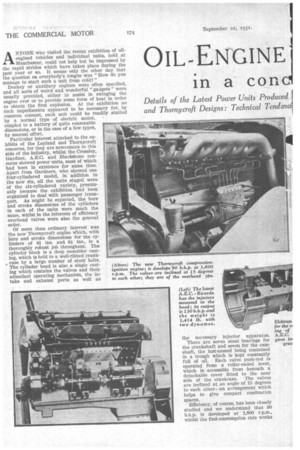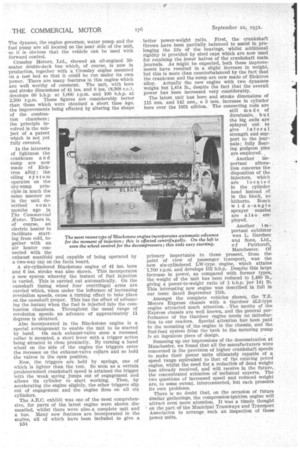OIL-ENGINE
Page 50

Page 51

Page 52

If you've noticed an error in this article please click here to report it so we can fix it.
in a conc
rete form ANYONE who visited the recent exhibition of oilengined vehicles and individual units, held at
Manchester, could not help but be impressed by the rapid strides which have taken place during the past year or so. It seems only the other day that the question on everybody's tongue was "110w do you manage to start such a unit from cold?"
Donkey or auxiliary engines were often specified, and all sorts of weird and wonderful " gadgets " were usually provided, either to assist in swinging the engine over or to provide some form of heat in order to obtain the first explosion. At the exhibition no such impedimenta appeared to be necessary for, by common consent, each unit could be readily started by a normal type of electric motor, , coupled to a battery of quite reasonable dimensions, or in the case of a few types, by manual effort.
Particular interest attached to the exhibits of the Leyland and Thornycroft concerns, for they are newcomers to this side of the industry, whilst the Crossley, Gardner, A.E.C. and Blackstone concerns showed power units, most of which had been in existence for some time. Apart from Gardners, who showed one four-cylindered model, in addition to the new six, all the units staged were of the six-cylindered variety, presumably because the exhibition hail been organized to deal with passenger transport. As might be expected, the bore and stroke dimensions of the cylinders in each of the units were much the same, whilst in the interests of efficiency overhead valves were also the general order.
Of more than ordinary interest was the new Thornycroft engine Which, with bore and stroke dimensions for the cylinders of 41 ins. and 64 ins., is a thoroughly robust job throughout. The cylinder block is a deep monobloc casting, which is held to a well-ribbed crank, case by a large number of stout bolts. The cylinder head is also a single casting which contains the valves and their attendant operating mechanism, the intake and exhaust ports as well as
Elektron for the ci ing of the necessary injector apparatus. A.E.C. There are seven stout bearings for gives log the crankshaft and seven for the camgrea shaft, the last-named being contained in a trough which is kept constantly full of oil. Each valve push-rod is operated from a roller-ended lever, which is accessible from beneath a detachable cover fitted to the near side of the crankcase. The valves are inclined at an angle of 15 degrees to each other—an arrangement which helps to give compact combustion spaces.
Efficiency, of course, has been closely studied and we understand that 90 b.h.p. is developed at 1,800 r.p.m., whilst the fuel-consumption rate works out at the figure .43 lb per b.h.p.-hour.
The distribution gear consists of a cembined chain and spur-gear layout. The chain embraces the crankshaft, dynamo, camshaft and fan spindle, whilst the drive for the fuel pump is obtained from a spiral spur gear which meshes with a similar type of pinion mounted on the camshaft. There is an eccentrically mounted chain tensioner capable of being operated by hand, and a Coventry automatic tensioner situated between the camshaft and the fan sprocket. • Fuel is supplied to the engine by a small pump driven off the rear end of the crankshaft. It is also interesting to note that the crankcase breathing arrangements are effected through the push-rod holes (which, of course, connect the crankcase itself and the valve chest), a pipe being led from the chest to the air intake in order to cut down so far as possible all chance of fumes escaping into the interior of the vehicle.
Although the engine was shown in a 6-ton fourwheeled chassis with normal control, it is obvious that the unit has been designed to suit the requirements of forward-control vehicles, for all the components, such as the dynamo, governor, fuel pump and injectors, etc., are located on the near side of the engine.
Another very interesting machine shown at the exhibition for the first time was a Leyland oil-engined chassis. This unit also has six cylinders and, in all respects, is a thoroughly neat unit. The bore of the cylinders is 41 ins., and the piston stroke 5i ins.; that efficiency may be judged by the fact that 78 b.b.p. is available at 1,000 r.p.m. After prolonged tests it has been found possible to maintain 13 m.p.g. during general running.
The machine shown was one of an experimental batch of vehicles built for subjection to exhaustive road tests, which are actually taking place at the present time. The power unit is of the directinjection, compression-ignition type, and is interchangeable with the maker's well-known T-type petrol engines. Chassis with these engines are not being offered for sale at the moment, as the prolonged road tests have not yet been concluded.
Externally the engine Is clearly a Leyland product, for the disposition of the main components and the layout of the fan drive, etc., are similar to those of the petrol units. The cylinders are cast en bloc with a separate head, which is also a monobloc casting ; the lower half of the crankcase is of a deep, well-ribbed formation, and is enclosed at the bottom by a large-capacity oil sump, the main container of which is situated at the rear end in order to avoid fouling the front axle and track rod. Overhead valves are operated by an overhead camshaft. The dynamo, the engine governor, water pump and the fuel pump are all located on the near side of the unit, so it is obvious that the vehicle can be used with forward control.
Crossley Motors, Ltd., showed an oil-engined 50seater double-deck bus which, of course, is now in production, together with a, Crossley engine mounted on a test bed so that it could be run under its own power. There are many features in this engine which are well worthy of comment. The unit, with bore and stroke dimensions of 41f ins. and 6 ins: (8,368 c.c.), develops 60 b.h.p. at 1,000 r.p.m. and 100 b.h.p. at 2,500 r.p.m. These figures are considerably better than those which were obtained a short time ago, the improvements being effected by altering the shape of the combus tion chambers ; the principle in volved is the subject of a patent which is not yet fully covered.
In the interests of lightness the crankcase a n d sump are now made of Elek tron alloy ; the oiling system operates on the dry-sump prin
ciple in much the same manner as
In the unit de scribed some months ago in
The Commercial Motor. There is, of course, an
electric heater to facilitate starting from cold, to gether with an air heater connected with the exhaust manifold and, capable of being operated by a two-way tap on the facia board.
A six-cylindered Blackstone engine of 41 ins, bore and 6 ins, stroke was also shown. This incorporates a new system whereby the instant of fuel injection is varied. This is carried out automatically. On the camshaft timing wheel four centrifugal arms are carried which, when under the influence of increasing revolution speeds, cause a turning effect to take place on the camshaft proper. This has the effect of advancing the instant when the fuel is injected into the combustion chambers. Throughout the usual range of revolution speeds an advance of approximately 11 degrees is obtained.
Also incorporated in the Blackstone engine is a special arrangement to enable the unit to be started by hand. On each exhaust-valve stem a recessed collar is mounted, a short lever with a trigger action being situated in close proximity. By turning a hand wheel on the side of the engine the triggers enter the recesses on the exhaust-valve collars and so hold the valves in the open position.
Now, the triggers are held by springs, one of which is lighter than the rest. So soon as a certain predetermined crankshaft speed is attained the trigger with the weak spring jumps out of engagement and allows its cylinder to start working. Then, by accelerating the engine slightly, the other triggers slip out of engagement and the engine fires on all six cylinders.
The A.E.C. exhibit was one of the most comprehensive, for parts of the latest engine were shown dismantled, whilst there were also-a complete unit and a bus. Many new features are incorporated in the engine, all of which have been included to give a The most recent type of Blackstone for the moment of injection ; this i seen the wheel control for the de better power-weight ratio. First, the crankshaft throws have been partially balanced to assist in prolonging the life of the bearings, whilst additional rigidity is provided by steel caps which are now used for retaining the lower halves of the crankshaft main journals. As might be expected, both these improvements have resulted in a slight increase in weight, but this is more than counterbalanced by the fact that the crankcase and the sump are now made of Elektron alloy. Actually the new engine with two dynamos weighs but 1,414 lb., despite the fact that the overall power has been increased very considerably.
The latest unit has bore and stroke dimensions of 115 mm and 142 min., a 5 trim. increase in cylinder bore over the 1931 edition. The connecting rods are still made of duralumin, b u t the big ends are splayed out to give lateral strength and support to the journals; fully floating gudgeon pins are employed.
Another important alteration concerns the disposition of the injectors, which are located in the cylinder head instead of in the block, as hitherto. Bosch w i d e-angle sprayer nozzles are also employed.
Another i m portant exhibitor was L. Gardner and Sons, Ltd., o f Patricroft,
Manchester. Of primary importan-ce to those present, from the point of view of passenger transport, was the new six-cylindered LW-type engine, which attains
• 1,700 r.p.m. and develops 102 blip. Despite this large increase in power, as compared with former types, the weight of the unit has been reduced to 1,480 lb., giving a power-to-weight ratio of 1 b.h.p. per 14i lb. This interesting new engine was described in full in our issue dated September 15th.
Amongst the complete vehicles shown, the T.S. Motors Express chassis with a Gardner 4L2-type engine attracted much attention. The merits of the Express chassis are well known, and the general performance of the Gardner engine needs no introduction to our readers. Special attention has been paid to the mounting of the engine in the chassis, and the fuel-feed system from the tank to the metering pump is an ingenious piece of design.
Summing up our impressions of the demonstration at Manchester, we found that all the manufacturers were concerned in the provision of higher crankshaft speeds to make their power units ultimately capable of a speed range equivalent to that of t4e existing petrol engine, whilst the need for a reduction of dead weight • has already received, and will receive in the future, the concentrated attention of technical experts. The two questions of increased speed and reduced weight are, to some extent, interconnected, but each presents its own problems.
There is no doubt that, on the occasion of future similar gatherings, the compression-ignition engine will attract even: more attention. It was a timely thought ' on the part of the Municipal Tramways and Transport Association to arrange such an inspection of these power units.




































































































